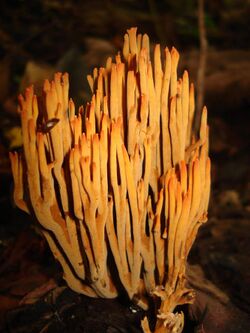Biology:Ramaria cokeri
From HandWiki
Short description: Species of fungus
| Ramaria cokeri | |
|---|---|

| |
| Found in Veracruz, Mexico | |
| Scientific classification | |
| Domain: | Eukaryota |
| Kingdom: | Fungi |
| Division: | Basidiomycota |
| Class: | Agaricomycetes |
| Order: | Gomphales |
| Family: | Gomphaceae |
| Genus: | Ramaria |
| Species: | R. cokeri
|
| Binomial name | |
| Ramaria cokeri R.H. Petersen (1976)
| |
| Synonyms[2] | |
|
Phaeoclavulina cokeri (R.H.Petersen) Giachini (2011)[1] | |
Ramaria cokeri is a coral mushroom in the family Gomphaceae. It was described in 1976 from the Appalachian Mountains in the United States.[3] Some authors have proposed to place the species in a separate genus Phaeoclavulina based on molecular analyses,[1][4] but this was explicitly rejected in a subsequent publication due to the resulting morphological variability of the resulting genus.[5]
The species has been reported from Japan, Mexico, Colombia, Malaysia, Indonesia, Sri Lanka, Pakistan, Papua New Guinea, Solomon Islands, and New Zealand. In 2012, it was reported for the first time from the Canary Islands and Guinea.[5]
References
- ↑ 1.0 1.1 "A new taxonomic classification for species in Gomphus sensu lato". Mycotaxon 115: 182–201. 2011. doi:10.5248/115.183.
- ↑ "Ramaria cokeri R.H. Petersen :291, 1976". MycoBank. International Mycological Association. http://www.mycobank.org/BioloMICS.aspx?Table=Mycobank&Rec=87676&Fields=All.
- ↑ The Distributional History of the Biota of the Southern Appalachians. Part IV. Algae and Fungi. Biogeography, Systematics, and Ecology. Charlottesville, Virginia: University Press of Virginia. 1976. p. 291. ISBN 978-0813906607.
- ↑ "Phylogenetic relationships of the Gomphales based on nuc-25S-rDNA, mit-12S-rDNA, and mit-atp6-DNA combined sequences". Fungal Biology 114 (2–3): 224–34. 2010. doi:10.1016/j.funbio.2010.01.002. PMID 20943133. http://www.fs.fed.us/pnw/pubs/journals/pnw_2010_giachini001.pdf.
- ↑ 5.0 5.1 "Notas en Gomphales V: Primeros Registros de Ramaria cokeri R.H. Petersen, para Macaronesia y África". Cryptogamie, Mycologie 33 (4): 481–88. 2012. doi:10.7872/crym.v33.iss4.2012.481.
Wikidata ☰ Q7289048 entry
 |

